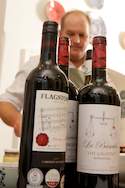Bruce Jack worked a vintage for UK Master of Wine Angela Muir and BRL Hardy as a cellar-hand in France at various Entre-deux-Mers co-operatives and small Bordeaux properties. This is where he encountered 'Claude', the head winemaker at one of the co-ops 'who taught me to always talk lovingly to my yeast inoculums and introduced me to really good rosé'.

It was after one of the many harvest lunches with Claude 'including the best cassoulet I'd ever tasted, a Pineau des Charentes, six vintages of the winery's reserve red blend, and a generous Armagnac', that the lightning bolt struck: literally.
While cleaning a massive stainless steel filter outside the cellar with a thunderstorm breaking, lightning struck the machinery, and Bruce was thrown to one side by the electrical charge. 'Lying on my back in the mess of mud and grape skins, I realised how happy I was.'
In 1995 Bruce Jack enrolled for the post-graduate degree in oenology and viticulture at Roseworthy College at the University of Adelaide in South Australia, 'simply because I believed it to be one of the best winemaking courses around'.
'Legendary' Simon Hackett in McLaren Vale and the 'hard man of Barossa' Grant Burge both 'taught me a great deal about the sharp end of the winemaking business.
Under Greg la Follette at model green cellar Flowers Vineyard and Winery in Sonoma Coast, California, he 'began to understand how to think like a grape'. He returned to South Africa and, in 1998, established Flagstone. Like Hackett, he too found himself as a winemaker without his own vineyards. Instead, Bruce Jack tramped (and still tramps with trademark Panama shielding him from the hot African sun) the vineyards of the Cape: from Darling up the West Coast to Elim on the southern Cape coast, from Constantia in the west to the Langkloof in the east.
Winkling out vineyards and negotiating with growers, he trucked in grapes that took his fancy for vinification in his small budget 'winemaking plant' in a Cape Town docklands warehouse. Having worked and studied in the Old and New Worlds, Bruce was borrowing from both: traditional or 'natural' winemaking methods (cold soaks, wild yeasts, no fining agents, no sulphur as preservative) made practical with particular pieces of carefully chosen equipment, engineering, and technology.
'Thinking like a grape' engendered a firm belief in the soft touch throughout the process of turning grapes into wine. This labour intensive modus operandi and open-minded approach to experimentation and new ideas were to make Flagstone and all Bruce's subsequent ventures a team effort, always, and a magnet for adventurous, talented young winemaking interns.
 Scrambled eggs recipe by Bruce Jack paired with CWG Flagstone Weather Girl or CWG Flagstone Happy Hour wine....
Scrambled eggs recipe by Bruce Jack paired with CWG Flagstone Weather Girl or CWG Flagstone Happy Hour wine.... Shiitake mushroom, organic spinach, and kale risotto with gremolata and white truffle oil recipe by Bruce Jack....
Shiitake mushroom, organic spinach, and kale risotto with gremolata and white truffle oil recipe by Bruce Jack....